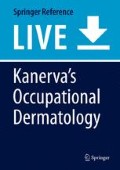Abstract
-
In the manufacture of aircraft, traditional mechanical techniques are used for the assembly, often combined with chemical techniques. Handling and exposure to metals and chemicals are therefore extensive.
-
Occupational skin diseases in this industry are well known.
-
Irritant contact dermatitis is considered to be more common than allergic contact dermatitis.
-
Common allergic contactants in an aircraft factory are sealants, epoxy resins, epoxy resin accelerators, preservatives, chromates, and nickel.
-
It is important to patch test with work materials since many chemicals used in the trade are not present in commercially available patch test series.
-
Subungual pulpitis caused by handling of epoxy resins and sealants based on synthetic rubber is considered to be specific for the aircraft industry.
-
Minimizing the contact with skin-irritating chemicals and/or allergenic chemicals by using proper protective clothing when “no touch” techniques cannot be employed is also important.
References
Aalto-Korte K, Pesonen M, Suuronen K (2015) Occupational allergic contact dermatitis caused by epoxy chemicals: occupations, sensitizing products, and diagnosis. Contact Dermatitis 73:336–342
Ayala F, Lembo G, Balato N et al (1990) The use of laboratory methods in contact dermatitis induced by composite materials. Contact Dermatitis 22:262–266
Beck MH (1989) Experiences of contact dermatitis associated with phenol formaldehyde resins. In: Frosch PJ, Dooms-Goossens A, Lachapelle J-M, Rycroft RJG, Sheper RJ (eds) Current topics in contact dermatitis. Springer, Berlin
Björkner B (1992) Plastic materials. In: Rycroft RJG, Menné T, Frosch PJ, Benezra C (eds) Textbook of contact dermatitis. Springer, Heidelberg
Bruze M (1988) Patch testing with a mixture of 2 phenol-formaldehyde resins. Contact Dermatitis 19:116–119
Bruze M, Trulsson L, Bendsöe N (1992) Patch testing with ultrasonic bath extracts. Am J Contact Dermat 3:133–137
Bruze M, Edenholm M, Engström K et al (1996) Occupational dermatoses in a Swedish aircraft plant. Contact Dermatitis 34:336–340
Burrows D (1983) Adverse chromate reactions in the skin. In: Burrows D (ed) Chromium metabolism and toxicity. CRC Press, Boca Raton
Burrows D, Fregert S, Campbell H et al (1984) Contact dermatitis from the epoxy resins tetraglycidyl-4,4′-methylene dianiline and O-diglycidyl phthalate in composite material. Contact Dermatitis 11:80–82
Castelain P-Y, Com J, Castelain M (1992) Occupational dermatitis in the aircraft industry: 35 years of progress. Contact Dermatitis 27:311–316
Cronin E (1980) Metals. In: Cronin E (ed) Contact dermatitis. Churchill Livingstone, Edinburgh
Dahlquist I, Fregert S (1979) Contact dermatitis from volatile epoxy hardeners and reactive diluents. Contact Dermatitis 5:406–407
Eedy DJ (1996) Carbon-fibre-induced airborne irritant contact dermatitis. Contact Dermatitis 35:362–363
Hackett JP (1999) Allergic contact dermatitis in American aircraft manufacture. Am J Contact Dermat 10:157–166
Hafner J, Rüegger M, Kralicek P et al (1995) Airborne irritant contact dermatitis from metal dust adhering to semisynthetic working suits. Contact Dermatitis 32:285–288
Hall AF (1944) Occupational contact dermatitis among aircraft workers. JAMA 125:179–185
Handley J, Burrows D (1994) Dermatitis from hexavalent chromate in the accelerator of an epoxy sealant (PR1422) used in the aircraft industry. Contact Dermatitis 30:193–196
Jappe U, Geier J, Hausen BM (2005) Contact vitiligo following a strong patch test reaction to triglycidyl-p-aminophenol in an aircraft industry worker: case report and review of the literature. Contact Dermatitis 53:89–92
Kanerva L, Jolanki R, Estlander T et al (2000) Airborne occupational allergic contact dermatitis from triglycidyl-p-aminophenol and tetraglycidyl-4,4′-methylene dianiline in preimpregnated epoxy products in the aircraft industry. Dermatology 201:29–33
Khanna M, Sasseville D (2001) Occupational contact dermatitis to textile dyes in airline personnel. Am J Contact Dermat 12(4):208–210
Lembo G, Balato N, Cusano F et al (1989) Contact dermatitis to epoxy resins in composite material. In: Frosch PJ, Dooms-Goossens A, Lachapelle JM, Rycroft RJG, Scheper RJ (eds) Current topics in contact dermatitis. Springer, New York, pp 377–380
Mathias CGT (1987) Allergic contact dermatitis from a nonbisphenol A epoxy in a graphite fiber reinforced epoxy laminate. J Occup Med 29:754–755
Pesonen M, Suuronen K, Jolanki R et al (2015) Occupational contact dermatitis caused by aniline epoxy resins in the aircraft industry. Contact Dermatitis 73:113–118
Pirilä V (1950) Thiocol as a frequent cause of dermatitis. Acta Allergol 3:319–328
Rietschel RL, Fowler JF Jr (eds) (1995) Fisher’s contact dermatitis, 4th edn. Williams and Wilkins, Baltimore
Wilkinson SM, Beck MH (1993) Allergic contact dermatitis from sealants containing polysulphide polymers (Thiocol®). Contact Dermatitis 29:273–274
Author information
Authors and Affiliations
Corresponding author
Editor information
Editors and Affiliations
Rights and permissions
Copyright information
© 2018 Springer International Publishing AG
About this entry
Cite this entry
Isaksson, M. (2018). Aircraft Industry. In: John, S., Johansen, J., Rustemeyer, T., Elsner, P., Maibach, H. (eds) Kanerva’s Occupational Dermatology. Springer, Cham. https://doi.org/10.1007/978-3-319-40221-5_116-2
Download citation
DOI: https://doi.org/10.1007/978-3-319-40221-5_116-2
Received:
Accepted:
Published:
Publisher Name: Springer, Cham
Print ISBN: 978-3-319-40221-5
Online ISBN: 978-3-319-40221-5
eBook Packages: Springer Reference MedicineReference Module Medicine

